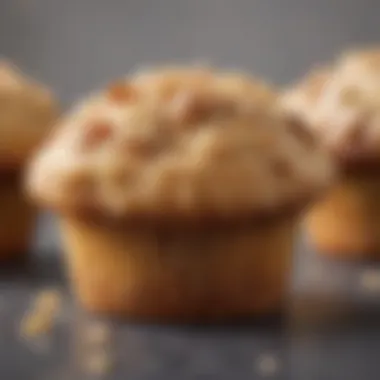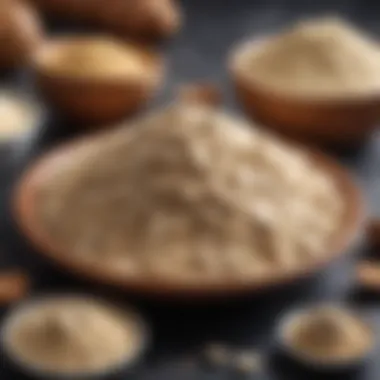Best Whey Protein Powder for Baking Tips


Intro
Whey protein powder has become quite the star in kitchens, especially among those who seek to boost their baked goods' nutritional content without compromising taste. Oftentimes, bakers shy away from integrating protein powder due to the uncertainty surrounding its impact on texture and flavor. However, this article will navigate the intricate relationship between whey protein and baking, offering insights that marry nutrition with culinary creativity.
The appeal of incorporating whey protein into recipes extends beyond just health benefits; it can also transform the texture of pastries, breads, and even cakes. Imagine whipping up a batch of brownies that not only satisfy chocolate cravings but also deliver a protein boost that can keep you going throughout the day. This guide aims to illuminate not just the types of whey protein available, but also how to seamlessly blend them into your favorite recipes.
As we explore the various aspects of whey protein powder—from understanding the different types to optimal baking methods—this article will serve as a comprehensive resource. With details on popular whey brands, key baking tips, and delicious recipes up our sleeve, you’re invited to embark on a flavorful journey that promises to elevate your baking game.
So roll up your sleeves, gather your ingredients, and let’s dive into the world of baking with whey protein.
Understanding Whey Protein Powder
In the realm of baking, whey protein powder often doesn’t get the spotlight it deserves. Understanding what whey protein powder actually is can significantly elevate your culinary game. This section aims to demystify whey protein, explaining its definition, composition, and various types. Knowing these elements enables bakers to make informed choices, leveraging the nutritional benefits of whey protein to enhance their baked creations.
Definition and Composition
Whey protein is a high-quality protein made from the liquid byproducts of cheese production. When milk is turned into cheese, whey is separated out and then processed to create protein powder. This powder is rich in essential amino acids, which are vital for muscle growth and repair, making it a favorite among fitness enthusiasts. Importantly, whey protein is composed of various bioactive compounds that can boost not just physical health but also the baking experience.
Types of Whey Protein
Whey protein comes in different forms, each with its own unique set of characteristics. Knowing the differences can guide bakers in selecting the right type for their recipes, and help maximize the benefits.
Concentrate
Whey protein concentrate is the least processed form of whey protein. It's typically about 70-80% protein, along with fats and carbohydrates. This balance of nutrients is attractive to many bakers because it provides a creamier texture and richer flavor in baked goods. The key characteristic of concentrate is its natural taste, making it a popular choice for those who want to enhance flavor without added sugars. However, its lower protein content compared to Isolate may not make it ideal for everyone. A unique feature of concentrate is its cost-effectiveness; it's usually less expensive than other forms, making it accessible for home bakers.
Isolate
Whey protein isolate undergoes more processing, resulting in a purer form containing about 90% protein. This type is lower in fat and carbohydrates, appealing to those seeking to maximize protein intake without added calories. A beneficial aspect of isolate is its versatility in baking; it integrates well into various recipes without altering the flavor significantly. However, this high purity may come at a premium cost. One consideration with isolates is that they can be slightly more expensive compared to concentrates, which may make some bakers hesitate to use it regularly.
Hydrolysate
Hydrolyzed whey protein is pre-digested using enzymes, which means it has been broken down into smaller peptide chains. This process allows for quicker digestion and absorption, offering an edge for athletes or those post-workout. A key characteristic of hydrolysate is its rapid absorption. This feature can be a game-changer if you're looking to boost protein intake rapidly after exercising, but for baking, this offers hydration benefits that could keep your baked goods moist. Yet, the taste can be a bit more bitter compared to isolate and concentrate. Furthermore, it is often the most expensive option, potentially limiting its use for those on a budget.
Understanding these types of whey protein can greatly aid in selecting the right kind for your baking needs, ultimately enhancing both nutrition and flavor.
Nutritional Benefits of Whey Protein in Baking
Baking is often seen as an art, but it's also a science, especially when it comes to the ingredients used. One star ingredient that has gained traction in recent years is whey protein powder. Incorporating whey protein into baked goods not only enhances their nutritional profile but also can influence the overall baking experience. Let's dive into the specific benefits of using whey protein in baking and how it can boost both flavor and nutrition.
Protein Enrichment
Whey protein is a powerhouse when it comes to protein content. When added to a recipe, it helps elevate the overall protein level in baked goods, which can contribute to a more balanced diet. For many, especially those looking to increase protein intake—be it for fitness goals or general health—it can be a simple way to enhance nutrition with minimal effort.
The addition of whey protein can also make baked goods more satisfying. Think about a traditional pancake. You toss in a scoop of whey protein, and suddenly what could have been a run-of-the-mill breakfast becomes a hearty meal that fuels you much longer. Not only that, but you’re likely to feel full and less tempted to snack shortly after.
Amino Acid Profile
Whey protein is rich in essential amino acids, particularly leucine, which plays a critical role in muscle synthesis and recovery. This amino acid is a building block for muscle growth, making it a popular choice among fitness enthusiasts. The profile of amino acids in whey protein is much more diverse when compared to other protein sources, like plant-based proteins.
In the context of baking, when you mix this protein into your favorite recipes, you're not just adding bulk to your treats. You're also giving them a nutritional makeover that supports muscle recovery and overall health. Whether it’s a protein-packed muffin for breakfast or high-protein cookies as a snack, the amino acid content can significantly boost their effectiveness as part of a post-workout meal.


Impact on Satiety
Ever notice how some foods keep you full for hours while others leave you hungry soon after? That’s where whey protein shines. Foods enriched with protein, like those made with whey, tend to provide greater satiety. This means they not only fill you up but also help curb hunger pangs later on.
In practical terms, this can be especially useful for those looking to manage their weight or simply avoid impulsive snacking. For instance, a protein-enriched brownie can serve as a more filling dessert compared to a regular one, which might leave you rummaging for more sweets shortly after.
"Incorporating whey protein into baking is not just about improving nutrition; it's about embracing a lifestyle that understands the balance between flavor and health."
When the benefits of whey protein are put into perspective, it becomes clear why it's a favored ingredient for many bakers who seek to create health-conscious recipes without sacrificing taste.
Ultimately, understanding the nutritional benefits of whey protein is crucial not only for those aiming for healthier baked goods but also for anyone interested in adding a more enriching element to their culinary creations.
Choosing the Right Whey Protein for Baking
When venturing into the realm of baking, the choice of whey protein powder is a pivotal factor that can transform your culinary creations. It's not just about adding protein; it’s about complementing flavors, enhancing textures, and achieving the right finish in your baked goods. Selecting the right whey protein can determine whether your muffins rise like they should or whether your pancakes are fluffy or dense. Understanding the nuances of flavor, texture, and even brand options becomes essential.
> Choosing the right whey protein is about marrying nutrition with taste and texture for your baked delights.
Flavor Considerations
Vanilla
Vanilla whey protein is often seen as the universal favorite among bakers. Its subtle sweetness and aromatic profile can enhance the flavor of a variety of baked goods without overpowering them. Vanilla pairs well with both sweet and savory recipes, making it a versatile option for everything from smoothies to cookies. One unique feature of vanilla whey protein is its ability to complement other flavors, making it a go-to choice for bakers looking to find a balance in their creations. However, its mild flavor may sometimes get overshadowed if used excessively with very strong ingredients, such as dark chocolate or spices.
Chocolate
Chocolate whey protein appeals to those who crave a richer flavor profile. Its deep cocoa undertones can elevate desserts from ordinary to extraordinary. The key characteristic of chocolate whey is its robust taste which can seamlessly transition your baked goods into indulgent treats. This flavor is especially beneficial for recipes where chocolate is the star, as it enhances depth and richness. Nevertheless, it's worth noting that, when baked, chocolate whey may leave a slightly denser texture, so adjusting liquid ingredients is often necessary to maintain fluffiness.
Unflavored
Unflavored whey protein is the quiet achiever in the protein powder game. It doesn’t contribute any flavor, allowing the natural tastes of your ingredients to shine. This neutrality makes it a smart choice for more complex recipes where you don’t want additional flavors muddying the waters. It can be particularly advantageous when added to savory baked goods like bread or pizza dough. The downside is that it might lack the intriguing notes that flavored options provide, so finding that extra something in other complementary ingredients becomes essential.
Texture and Solubility
The texture of your baked goods can greatly benefit from the right whey protein. When selecting a whey protein, solubility is key—some proteins dissolve better than others. Protein powders that dissolve easily will incorporate into batters without forming clumps, ensuring a smooth consistency. The goal is to achieve a light, airy texture that resembles traditional baked goods, rather than something tough or rubbery. Understanding your recipe and closely observing how different powders affect batter thickness can guide you on which protein performs best in your baking pursuits.
Brand Comparisons
The market offers a crowded space of whey protein brands, making selections overwhelming. Each brand often has unique formulations and quality standards. For example, some brands like Optimum Nutrition are known for their consistency and solubility, while others, such as Dymatize, highlight a diverse range of flavors. Price points can vary widely, so it’s wise to balance cost with quality. Another aspect to consider is the added ingredients; some brands might include fillers or artificial sweeteners, which could impact the natural taste of your baked goods. Reading labels and perhaps experimenting with a few options can shed light on which brands best align with your baking goals.
Integrating Whey Protein into Baking Recipes
Integrating whey protein into baking recipes goes beyond merely tossing in a scoop to your favorite batter. It’s about elevating the nutritional profile and improving the overall goodness of the baked goods. Whey protein is known for its rich amino acid content, which aids not just in muscle recovery but can also contribute to better health outcomes. The proper incorporation of whey protein can minimize some of the usual pitfalls in baking, such as issues with texture or flavor, all while maintaining that delightful indulgence that baked treats are known for.
Measurement Guidelines
When it comes to baking with whey protein powder, correct measurement is critical. If you’re not careful, you might find the texture of your baked goods turning into something more akin to a brick than a fluffy muffin. A good rule of thumb is to replace about ¼ to ½ of the flour in your recipe with whey protein. This proportion usually balances the structure of the final product while still allowing it to rise and maintain that fluffy texture you crave.
A small kitchen scale can be your best friend here. Whey protein frequently varies in density across brands, so measuring by weight rather than volume will ensure accuracy. Remember, precision is key!
Complementary Ingredients
Flours


When selecting flours, the type you choose can greatly affect the outcome of your baking endeavors. For instance, whole wheat flour brings a nuttiness to the table, while almond flour adds an entirely different level of moisture and flavor. All-purpose flour is generally most popular, but it might not always deliver that boost of protein that some bakers crave in their recipes.
Key Characteristics:
All-purpose flour tends to be versatile, making it a staple in many kitchens. It provides a smooth texture and structure to your baked goods.
Advantages/Disadvantages:
Using specialty flours can mean greater flavor and nutrition, but they might also result in denser baked items. For those who are just starting, keeping it simple with all-purpose may be beneficial until you find your groove.
Sweeteners
Sweeteners can undeniably alter the flavor profile of your baked goods. Natural sweeteners such as honey and maple syrup not only provide sweetness but can also work harmoniously with the whey protein. Both can introduce moisture, balancing the absorbent qualities of protein powder.
Key Characteristics:
Natural sweeteners are often less processed than their refined counterparts. Using honey instead of sugar can give your cakes a hint of caramel flavor and extra moisture.
Advantages/Disadvantages:
While natural sweeteners can enhance flavors, they usually require adjusting other liquids in a recipe to prevent overly runny batter. Too much liquid can cause cakes to collapse.
Fats
Fats help impart richness and contribute to the tenderness of baked goods. Using healthier fat options, such as avocado oil or melted coconut oil, can make your treats light yet delicious. Adding fats can also enhance the flavor, making it rich but not overwhelmingly so.
Key Characteristics:
Healthy fats can provide moisture without the heaviness often associated with butter, while offering a pleasing mouthfeel.
Advantages/Disadvantages:
Too much fat can weigh down the final product, thus it's crucial to strike a balance. For beginners, reducing fat by a tablespoon or two can help avoid overly greasy outcomes.
Balancing Dry and Wet Ingredients
Balancing dry and wet ingredients when adding whey protein is another pivotal aspect of ensuring successful baking. Whey protein absorbs more moisture than standard flour, which can lead to dense, dry outcomes if you don't adjust for it. Generally, you might need to add an additional liquid, like milk or water, to the mix.
Consistently checking the batter texture before pouring it into the oven will also help prevent less-than-desirable results. Aim for a batter that is pourable yet holds its shape.
Ultimately, finding the right balance in your ingredients when integrating whey protein will lead to lighter, healthier, and more enjoyable baked creations.
Popular Recipes Featuring Whey Protein
When it comes to baking with whey protein, the kitchen transforms into a playground of possibilities. Integrating whey protein powder into your baked goods not only amplifies the nutritional value but also introduces a pleasurable texture and flavor. This section uncovers several popular recipes that showcase the versatility of whey protein, ensuring that health-conscious bakers do not compromise on taste or enjoyment.
Protein Pancakes
Protein pancakes stand as a breakfast staple for many seeking a quick yet nutritious meal. Incorporating whey protein into the mix adds a protein punch that fuels your day. You might find that traditional pancake recipes often fall short in protein content. By substituting part of the flour with whey protein, these pancakes morph into a hearty option, rich in both flavor and nutrition.
To whip up a batch, consider this simple recipe:
- 1 cup of oats (blended into flour)
- 2 scoops of vanilla whey protein
- 1 tablespoon of baking powder
- 1 cup of milk (dairy or plant-based)
- 1 egg
- Optional: sprinkling of cinnamon or chocolate chips
Mix the dry ingredients well, add the wet, and cook them on a skillet for a fluffy, satisfying result. Not only do they taste fantastic, they set you up for a productive day!
Whey Protein Muffins
Whey protein muffins provide another excellent avenue to infuse your diet with extra protein. These muffins are versatile, allowing for creativity with flavors and add-ins. You might prefer blueberries, nuts, or even coconut flakes to enhance flavor profiles.
A basic recipe might include:
- 1 cup whole wheat flour
- 2 scoops of chocolate whey protein
- 1/2 cup of brown sugar
- 1 cup of almond milk
- 1 egg
- 1 teaspoon vanilla extract
- Optional: 1 cup of your preferred fruit


Mix your ingredients, pour into muffin tins, and bake until golden brown. The result is a batch of muffins that are not only delectable but also provide lasting energy.
High-Protein Cookies
When the craving for sweets strikes, high-protein cookies can satisfy that urge without the guilt. Adding whey protein to cookie recipes doesn’t just uplift the nutritional value - it also helps achieve a chewy texture that is downright tempting.
Consider this cookie recipe:
- 1 cup of almond butter
- 1/2 cup brown sugar
- 2 scoops of unflavored whey protein
- 1 egg
- Optional: dark chocolate chunks or dried fruits
Combine the ingredients until a dough forms. Drop spoonfuls onto a baking tray and bake for around 10 minutes. You'll be left with cookies that linger in your mouth and, best of all, keep your protein levels up.
"Baking with whey protein is like adding a secret ingredient that transforms your typical recipes into healthier, satisfying treats."
Exploring these recipes not only enriches your meal plan but also hints at the broader creative potential when baking with whey protein. They are a testament to how health and taste can coexist in the baking world, and they encourage bakers of all skill levels to experiment with the magic of protein powder. This opens up paths for healthier lifestyles while still relishing the beloved act of baking.
Key Considerations for Baking with Whey Protein
When embarking on the adventure of baking with whey protein powder, several key factors should be kept in mind. Each element contributes to the final outcome, ensuring that baked goods not only taste great but also hold their desired texture and nutritional profile. Understanding these considerations can make the difference between a mediocre loaf and a showstopper cookie.
Texture Adjustments
Whey protein can dramatically alter the texture of your baked products. Regular flour contains gluten, which helps in achieving that fluffy, structured quality. However, whey protein does not have this property, which means you should be ready to adjust other ingredients accordingly. If you decide to substitute a portion of flour with whey protein, consider the following:
- Hydration Needs: With the addition of whey, the amount of liquid in your recipe may need to be increased since whey protein absorbs moisture. Start by adding an extra tablespoon of liquid for every scoop of whey protein you use.
- Fat Content: Adding a touch more fat, like butter or oil, can help maintain moisture content and counterbalance any potential dryness from the whey. Many bakers find that slightly richer cookies or cakes yield better results.
- Experimentation: Don't be afraid to play a little. Keep track of your ratios so you can replicate successful combinations. Depending on what you’re after, you might go for denser brownies or lighter muffins.
Baking Temperature and Time
Another critical element is adapting baking temperatures and timings. Whey protein can cook differently compared to standard baking ingredients, leading to unexpected results if not adjusted. Here are some guidelines to consider:
- Lowering the Temperature: It’s often recommended to lower the baking temperature by 25 degrees Fahrenheit. This gentle approach can prevent your baked goods from drying out or becoming overly tough, allowing for a more controlled cooking process.
- Extended Baking Times: Since whey protein can retain moisture, bakers might find that they need to add a few extra minutes to standard recipes. Keep an eye on color and texture; you can do a toothpick test to check for doneness. The toothpick should come out clean once you hit the right baking time.
"A good baker learns to listen to her creations; every tweak and adjustment reveals a world of delicious experimentation."
Storage and Shelf Life of Baked Goods
Understanding how whey protein impacts the shelf life and storage of your baked treats is key, especially if you like to bake in batches. Below are some insights:
- Moisture Retention: Baked goods made with whey protein often stay fresher for longer due to increased moisture retention. This is beneficial, especially for proteins-rich items like muffins and cookies that tend to dry out quickly.
- Proper Storage: To maintain their quality, always store these treats in airtight containers. For items like bread, you might want to wrap them in foil and then place them in a ziplock bag for an added layer of protection.
- Freezing Options: Most protein-enriched baked goods freeze well too. Make sure they cool completely before you store them in freezer-safe bags. When you’re ready to enjoy them, just pop them in the oven for a few minutes to freshen them up.
In sum, while baking with whey protein powder presents its own set of challenges, it also offers unique avenues for creativity and nutritional enhancement. By considering texture adjustments, baking temperature, and storage strategies, you’ll be better equipped to produce delightful and healthful baked items.
End
As we round up our exploration of whey protein powder’s potential in baking, it's crucial to reflect on what we’ve learned. First and foremost, we’ve established that integrating whey protein into recipes isn’t simply a health fad; it’s a practical approach to enriching the nutritional profile of various baked goods. The benefits stretch beyond just protein boosting. It’s about enhancing the taste, texture, and overall satisfaction of each bite. Baked items can retain moisture better when whey protein is added. This is particularly useful in achieving that soft and chewy texture many of us crave in recipes like cookies and brownies.
Summarizing Key Insights
- Nutritional Enhancement: Each serving of whey protein brings additional health benefits, making baked goods more desirable for those seeking protein-rich diets.
- Versatility in Recipes: From cookies to muffins, whey protein can be incorporated neatly into a variety of dishes without altering their intended flavor or texture drastically.
- Consideration of Types: Depending on your choice of whey protein—whether concentrate, isolate, or hydrolysate—you can tailor recipes to achieve desired richness and sweetness.
Ultimately, understanding these elements helps bakers of all skill levels leverage the potential of whey protein to not just create nourishment but also to enjoy the process of baking itself. Whey protein can indeed open up new avenues for both flavor and health.
Encouraging Experimentation in Baking
Encouragement is key when it comes to baking with whey protein. It’s essential to approach this ingredient with a spirit of adventure. Don’t be afraid to try out different brands and types to see which ones fit your tastes best. Perhaps you’ll discover that a chocolate-flavored isolate complements your double chocolate chip cookies perfectly, or maybe vanilla whey protein gives your pancakes an unexpected lift.
Experiment with the ratios as well. Start small; substituting 1/4 to 1/2 of your usual flour with whey protein can be a good approach. As you get comfortable, play around with larger proportions. Pay attention to how it affects baking time, moisture retention, and even the final flavor profile.
Consider inviting friends and family for a taste test of new recipes. Their feedback can guide your next baking venture. Influencing your baking journey with whey protein can transform routine recipes into more fulfilling and health-conscious treats. So roll up your sleeves, preheat that oven, and dive into the world of whey-enriched baking only limited by your creativity!







